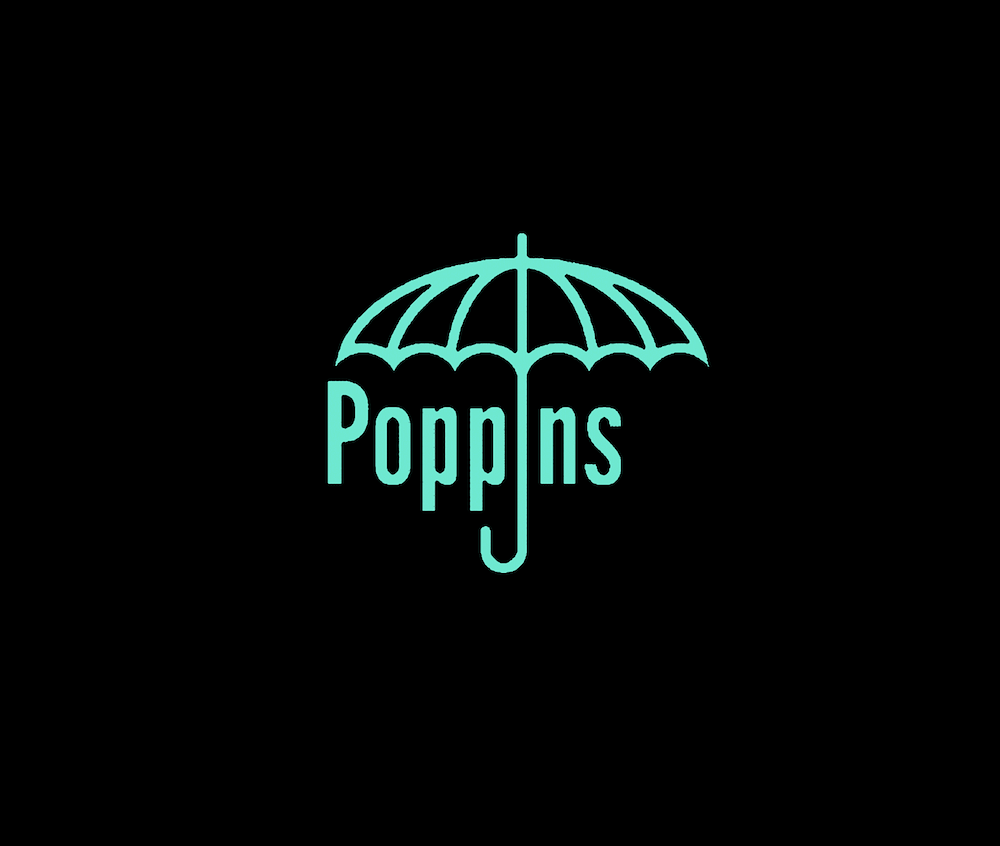Poppins
Mobile Application for Childcare Networking

Design Language &
Visual Direction
Goal: Project warmth, trust, and simplicity — appealing to parents and caregivers.
Core Visual Style:
- - Modern pastel palette: Soft gradients of mint, blush, and
- sunshine yellow for calmness and
- warmth.
- (Example:
#A8E6CF,#FFD3B6,#FFAAA5, #DCEDC1,#5E6472.)- - Rounded geometry: Keep all buttons, cards, and avatars rounded
- (16–24px radius) to signal friendliness.
- - Depth through subtle shadows: Replace flat dividers with soft
- elevation shadows.
- Typography:
- - Header: Poppins SemiBold (brand-consistent).
- - Body: Nunito Regular for approachability and readability.
- - Contrast ratio target: 4.5:1 minimum for accessibility.
Layout & Navigation
Header area:
- - Replace the large grey bar with a floating top navigation that
- slightly overlaps the content.
- - Keep the Poppins umbrella logo centered, but introduce a
- smaller hamburger icon with a softer drop shadow.
- - Use animation transitions for screen changes — slide-in from
- right for new pages, fade for modal confirmations.
Bottom navigation:
- - Simplify with a translucent frosted-glass effect (
backdrop- filter: blur(12px)).- - Active icon uses the brand’s accent color (
#00BFA5), while - inactive ones use soft neutral gray.
Availability Screen
Before:
Rigid grid, inconsistent spacing, low visual hierarchy.
After:
- Use profile cards with horizontal layouts:
- - Avatar on left (60–72px diameter).
- - Name, rate, and rating grouped neatly in a single column.
- - Location or “distance” represented by a colored map pin
- icon rather than small map tiles.
- Replace “map thumbnails” with a small badge (e.g. “1.2 mi away”) — then add a “View on Map” button at bottom of screen for spatial overview.
- Introduce filter chips instead of icons (Distance • Rate • Reviews • Friends):
- - Interactive, toggles with light gradient fill.
- - Sticky horizontal scroll bar for filters.
Caregiver Requests Screen
Before:
- Overlapping colors and inconsistent visual weight.
After:
- Each request becomes a card with color-coded urgency:
- - Red → “Now”
- - Orange → “Soon”
- - Mint → “Later”
- Avatar aligned left with name + short message preview.
- Replace the “+” icon with a rounded “Respond” button using accent color.
- Add a small timestamp (“2 hrs ago”) for temporal clarity.
- “Find a Caregiver” section:
- - Use segmented toggle buttons (Now / Soon / Later) with
- gentle shadows and hover states.
- - Add small icons (⏱️ clock, 🌤️ sun, 🌙 night) for better
- emotional resonance.
Confirmation Screen
Before:
- Plain, low contrast, lacks hierarchy.
After:
- Use a centered confirmation illustration (flat vector style
— e.g., caregiver with child).
- Display “Confirmed!” in large, rounded typography with a
confetti or checkmark animation.
- Convert the date/time/rate boxes into pill-shaped info
badges.
- - Add a “Share confirmation” CTA for calendar sync or text
- sharing.
Profile Screen
Before:
- Vertical chain of avatars feels dated.
After:
- Replace “connection ladder” with a horizontal scrollable carousel:
- - “1st Level” • “2nd Level” • “3rd Level” cards with small circular
- avatars and dotted connecting lines.
- - Map section redesigned as a mini map module with
- interactive radius visualization.
- - Use iconography with light outline style and consistent
- stroke width (24px, 1.5px stroke).
- - “Book Me” → replace with rounded primary button
- (
#FF6F61) and microtext: “Confirm & Message”.
Search Filter / Urgency Screen
Before:
- Flat teal layers with low differentiation.
After:
- - Use collapsible filter sections with soft shadows and clear
- spacing.
- - Replace checkboxes with pill-shaped toggles (selected →
- color fill; unselected → outlined).
- - Include a live preview map at bottom that updates as
- filters are adjusted.
- - Replace “Post” button with “Publish Request” (rounded,
- animated hover).
- Interaction & Motion Enhancements
- - Microanimations for state changes (favorite, confirmed, etc.).
- - Button tap feedback: subtle scale-up and color pulse.
- - Screen transitions: fade-slide combo (400ms).
- - Floating action buttons (FABs) for primary calls like “+ New
- Request”.
Accessibility & UX Refinements
- Ensure all text contrast > 4.5:1.
- Add voice-over labels for all icons (“Favorites tab”, “Confirm
booking”).
- Larger touch targets (min 44px).
- - Gentle haptic feedback on key actions (confirm, send, favorite).
Summary Tagline
“Poppins — Care that Connects.”
A friendly, trustworthy platform that feels human-first, blending warmth, clarity, and modern usability.
Best Friends
Responsive Application
for Pet Adoption

Design Vision
Goal: Make adopting pets feel warm, intuitive, and story-driven —
not transactional. Think: “Tinder meets storytelling” — a clean
UX powered by empathy and personality.
Visual Mood:
- - Friendly minimalism: Soft neutral backgrounds with bursts of
- cheerful color (orange, coral, mint).
- - Organic shapes: Rounded cards and gentle elevation to convey
- approachability.
- - Vivid photography: Center each pet’s personality — close-up
- portraits, minimal text.
- Typography:
- - Headers: Poppins Semibold
- - Body: Nunito Regular
- - All text high-contrast and large enough for mobile-first use.
Home Screen
Before:
- Dense with filters and mixed UI patterns.
After:
- - Hero area featuring a “Meet your next best friend” message and
- carousel of adoptable pets.
- - Replace the stacked filter chips with playful icon-based tiles (Dogs,
- Cats, Rabbits, etc.), using subtle animations.
- - Below: Quick categories (“Puppies,” “Seniors,” “Good with Kids”) as
- rounded gradient buttons.
- - CTA: Prominent “Start Searching” button centered with motion
- feedback.
Interaction
Upgrade:
- Soft horizontal scrolling and card parallax for engagement.
Adoptables / Pet Browser Screen
Before:
Polaroid-style cards stacked with harsh drop shadows.
After:
- Switch to horizontal swipe cards (Tinder-style interaction).
- Clean white cards with subtle drop shadows and rounded corners
(16px).
- Focus on large portrait photos, full-bleed, with minimal text overlay:
- – Pet name
- – Age, gender, location
- – Small icon row for tags (friendly, vaccinated, good with kids)
- - Replace large icons below with floating circular buttons:
- ❌ skip • ℹ️ info • ❤️ save.
UI detail:
- Add subtle micro-animations when liking, skipping, or viewing details (bounce, fade, swipe).
Bio / Pet Profile Screen
Before:
Basic card layout with blocky sections and static info.
After:
- Full-screen, edge-to-edge pet portrait at top with gradient overlay.
- Add soft scrolling header animation (pet name and details slide up as
you scroll).
- Replace orange boxes with expandable, collapsible info panels:
- – “Personality & Behavior”
- – “Medical History”
- – “Likes & Dislikes”
- Add an “Adopt Me” button that anchors persistently at the bottom with
soft glowing feedback.
- - Include a story element: short quote from volunteers (“Artie’s tail never
- stops wagging”).
Bonus:
- Photo carousel with heart icons for favoriting.